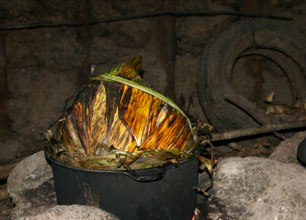If you have ever visited a rural community in the developing world, one of first olfactory sensations to hit you is that burning smell. Tracing it will more often than not take you indoors, where a woman is tending to her cook stove. It turns out that cooking dinner this way can have very harmful health effects. A 2007 World Heath Organization report cited respiratory illness from indoor cook smoke as the fifth highest cause of death for people in the developing world. In all, an estimated 1.9 million people die each year from the effects of this kind of indoor air pollution.
At the Clinton Global Initiative last year, Secretary Clinton announced a new partnership (which includes the UN Foundation) to create a market for clean cookstoves that can replace traditional cooking methods. Gretchen Goetz of Food Safet News has an excellent story about the problem–and the clean cook stove solution.
Implementing clean cookstoves is more complicated than simply installing a more efficient stove…Local people need to take ownership of their stoves in order to invest in using them rather than selling them. In the past, “NGO’s would give them a rain barrel and two months later they would sell it,” he says of Barillas residents. This is why Rotary works with them to form a payment plan so that they become owners of their stoves.
Stoves must also be durable. Many new stove technologies are being developed, but if they require maintenance, they will not be a sustainable solution for people who cannot afford it. “In Kenya, stoves are $2.50 to buy and get installed, but if they have to do that again every 6 months, it’s prohibitively expensive,” Falk explains. Stove durability is one of the issues the Global Alliance is currently addressing, he says.
Different cultures require different types of stoves to meet their cooking needs. The people of Barillas eat tortillas as virtually their only form of sustenance, according to Garrison, but villagers in a town in Africa might require a surface better-suited to boiling vegetables. Introducing the right type of stove is essential to ensuring that the culture will adapt it into daily use.
Finally, new cookstoves cannot be successful unless they eliminate the specific particles causing health dangers. As Falk says, “We’ve seen stoves where smoke gets reduced but the level of particles does not.” Just because a stove doesn’t emit black smoke does not mean the cloud of danger has cleared. Falk and others at the CDC are testing new stove technologies for the Global Alliance to ensure that they reduce disease-related particle emissions before they are put into place.
Read the whole story in Food Safety News. And visit the Global Alliance For Clean Cook Stoves for more.
